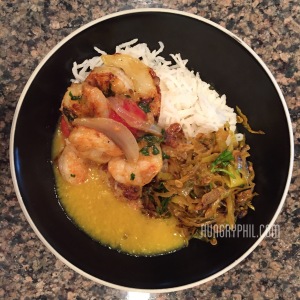There is a fair amount of gastronomic seduction and education involved in inviting another to one’s native culinary tastes. This is particularly the case when two people from different culinary traditions fall in love and regularly dine together. Jim and I have been together for five years. Through each other and with each other we have discovered many new tastes. This blog is partly an account of our dinner conversations. It is quite possible that we shared every meal you see posted on this site.
In the past five years, I learned to bake (a technique I unknowingly under-utilized before), cakes, chicken, casseroles, vegetables and more. I learned to make a variety of sauces. I learned to appreciate biscuits and gravy, grits and cheese and a variety of sweets I didn’t know existed, like Ritz crackers with peanut butter dipped in chocolate. I appreciate steaks and burgers as worthy treats. Pastas and salads have become very familiar. My pantry is the most diverse and global it has ever been. It is rare for us to go a week without dining on at least three different cuisines. This week, for example, we had Cajun inspired, Japanese inspired and Indian inspired meals.
But, my culinary evolution is small compared to Jim’s. He went from a diet of burgers, salads and packaged Italian meals to willingly eating fried anchovies and spicy vegetable curries. Food is so much better shared. I’m glad Jim is my food buddy.
Here was my intuitive strategy to introduce him to Bengali (South Asian) food:
Level 1: Comfort: Unfamiliar flavors with a familiar twist.
- Add cream/ sugar. Dishes like chicken rezala (an earlier posted recipe) made with a yogurt, ginger, garlic sauce work well. [Quick note: The layer of floating oil is unappealing to unaccustomed eyes. The aggressive look of red thick spicy sauce with a film of oil should be avoided as much as possible.]
- Cover with pastry: If I can’t see the unfamiliar filling then I can’t be too scared of it. Wrapping hides the unknown. Potato croquettes, samosas, vegetable koftas or fritters work well.
- Fry or grill: anything fried or grill has an automatic familiarity. Example, chicken tandoori.
Level 2: Complexity: Building expertise and letting go of familiar level 1 culinary crutches.
- Add more traditional ingredients: In stage one, I focused on familiar spices like ginger, garlic, onions, cinnamon, chili with the inclusion of no more than three unknown flavors, like turmeric, coriander, cumin etc. As familiarity builds, I felt okay adding saffron, cardamom, fennel seeds, mustard seeds etc,. For example, shrimp and pumpkin curry with coconut milk, coriander, cumin, garlic, onion, turmeric and chili.
- Remake restaurant dishes: Somehow standardized restaurant food acquires a level of shared cultural currency. We know Indian restaurant food well (unlikely we cook it at home), sag paneer, butter chicken, karahi ghost and the famed chicken tikka masala. The process of trying something together at a restaurant and then trying to cook it at home, makes it a shared discovery. For example, easy fake out butter chicken (recipe posted previously).
- Introduce traditional flavor combinations and progression. For example, a cucumber raita accompanies dry kabobs and biriyani dishes, not light currries, dal or vegetables. Or, rice flavored with curries is the main dish, not the meat curry.
Level 3: Comfort: Search for Variations
- This is when floating oil, involved and complex sauces and whole spices in the curry become less intimidating. For example, the spicy Shrimp curry recipe posted last month. Or the plate above with shrimp, dal and cabbage bhaji. This is the phase of native familiarity without the childhood nostalgia.
- Remake home cooking and regional variations. Now I feel comfortable making dishes I remember eating without worrying whether Jim will like it. His dislike at this point would be a personal taste preference instead of a quick reaction to the unknown.
As you can see, I thought about introducing Jim to flavors I love very consciously. I am thankful that Jim responded as well as he has. I am not alone in pondering these questions of cultural interpretation and translation. In the book, Food: The Key Concepts, Warren Belasco, writes about American preferences (for sweet and meat) and quotes culinary historian Laura Shapiro’s characterization of the Americanization of other culinary cultures by “blunting the flavors and dismantling the complications.” While the strategy of tempered flavors and complexities served well to introduce Jim to Bengali food, the continued discovery now makes it a shared adventure. For example, our first Michelin starred five-course dinner at San Francisco’s Compton Place (more on that meal later).
Wishing you gateway dishes that take you far away and bring you closer together,
Hungryphil





This is so incredibly helpful!!! thanks Lisa!
LikeLike
Thank you, Meg. “Eating” a new culture takes time and translation that most of us don’t realize. What’s the point of eating outside our comfort zone if not to develop aware appreciation (like art and music), right? I’m fascinated by Nordic food that seems so incredibly simple and naked from my perspective. I’ll have to make your Swedish cucumbers soon! Let’s make it together, bring another recipe that goes with it!
LikeLike